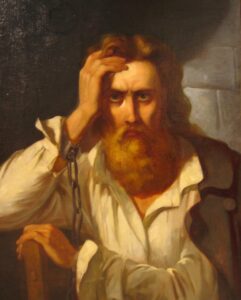He was 31 years old when, on 27 February 1839, he was shot by order of the tsarist court and secretly buried in Vilnius. Then his grave was trampled by horses so that no one could find it. And yet, just a few months later, the burial place was found, the body was secretly moved and buried in the Calvinist cemetery in Vilnius. What did Szymon Konarski (because he is the one we write about here) deserve death at the hands of the Russian invader and great respect from his compatriots?
He was born on 5 March 1808 in the Dobkiszki estate located in the former Grand Duchy of Lithuania. His origins marked his future: his father served in the national cavalry during the war against Russia in 1792 and took part in the Kościuszko Uprising. In turn, one of his grandfathers was a general of the Army of the Grand Duchy of Lithuania, and the other was a member of the Supreme Government Council of Lithuania during the Kościuszko Uprising. Konarski, sooner or later, had to fight for Poland’s freedom.
In 1826, after completing his education at schools in Sejny and Łomża, he joined the Polish Army of the Congress Kingdom. After a year, he became a non-commissioned officer, and during the November Uprising he was promoted to the rank of second lieutenant. He then took part, among others: in the famous Battle of Olszynka Grochowska and participated in General Dezydery Chłapowski’s expedition to Lithuania, during which he was captured by the Prussians. However, in 1832 he regained his freedom and emigrated to Western Europe. He stayed in Switzerland, where he learned the craft of watchmaking, and in France, where he became involved with the local revolutionaries. He soon returned to his homeland, where he was to spread the seeds of the revolution. Due to the local population’s lack of interest in progressive ideas, he made his way to the Prussian side of the border. Through a Prussian prison and Belgium, he ended up in the Kingdom of Sardinia, where he took part in the Savoy Uprising.
After the fall of the uprising, he lived again in France, where he started publishing the “Północ” [“Nord”] newspaper. Then he got involved with the political circle around Joachim Lelewel, on whose initiative he again went to Polish-Lithuanian lands in 1835. In the Free City of Cracow he signed with the Association of the Polish People. On behalf of the Association, he went to the lands of the Russian partition, where he was to unite numerous anti-Russian organizations into one – the Union of the Polish People. In 1837 he became its leader. However, he was soon arrested and imprisoned in Vilnius. Subjected to torture, he did not break down. He attributed all his conspiratorial activities to himself, thus defending his colleagues.
Prepared by Piotr Bosko




